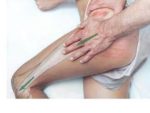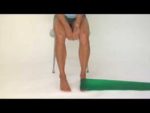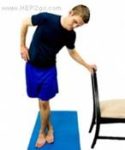The Iliotibial Band, Running, And Taking Care Of Yourself On The Road Or Trail
One of the great things about Victoria is that there are many excellent places to go running. There are good places to buy your shoes, a number of resources on how to get started and how to maintain your running style and many races to run throughout the year. Healthy and fun!
However, one of the downsides of the busy lifestyle here is that many people neglect to take care of themselves. Knee pain, especially along the outside of the knees, is common among runners, and can be prevented. Most often, I find that the reason that this pain presents is due to an overly tight iliotibial band, or ITB.
“What the heck is that?”

The ITB is a fibrous band that runs down the outside of the thigh, starting from your hip, and running just past your knee. You can most often find it by straightening your leg and running your hand down the outside of your thigh. It can be quite prominent just above the knee, where it dips in and almost forms a divot.
“Will finding this help my pain?”
Well, not exactly. Most people run in their spare time, and a great many of us have desk jobs these days. This means that our muscles, which were purposely developed for use as hunter-gatherers, are not being used in an effective manner; in most of us they are underutilized and weak, especially in the inner thigh. This creates quite the imbalance. In order to compensate, the outer thigh has to take up the slack, especially when doing something as active as running. Because of its attachment into the knee, the ITB now pulls hard on the knee as a counterbalance. This is the source of most complaints in regards to running.
I can help with this by working into the fibrous tissue of the ITB by using several different methods. I generally prefer to use range of motion while working into the fibrous tissue so there is not only an increased range of motion after your treatment, but also slackening of the tissue. This helps relax the tissue, and stops the ITB from pulling so hard on your knee. Heat is a good thing for pre-treatment, as it helps with tissue extensibility and allows for more blood flow into the area. I love my Thermophore for this purpose; it provides deep moist heat to the area and clients are able to better relax on the table.

Homecare is another important piece of treatment that I like to focus on, because the inner thigh needs strengthening too. Typically I like to have my clients use a piece of elastic tubing or other exercise elastic, and tie it to either a table leg or something that isn’t going to move very easily. Make sure you’re well supported and feel comfortable with the movement, remain either seated or standing. Maintain the elastic at the same height as your ankle so that you and your ankle are going to be able to handle the extra strain. Now, bring your straight leg across your body. Go slowly, and repeat for three sets of five.
After a run or if you feel like your ITB is really bothering you, you can also ice your thigh. I do have to ask a few things of you, however. Please, make sure that if you use an ice pack it does not touch your bare skin. Wrap it or make sure you’ve got on a pair of shorts or pants that go past the knee. You can use ice itself on your bare skin, but make sure you keep it moving, you keep the ice wrapped or in a container (except for the part touching your skin of course), and make sure it’s something you can handle. Don’t use ice or ice over any open wounds or sores. These points are imperative, especially if you’re adverse to cold or if you have any conditions that would slow healing. Of course, it’s necessary to do this within your own comfort zone. If you don’t like it or you’re not into it, please don’t do it.
 You can also stretch out the ITB by bringing your leg across your body so that you’re standing in a cross-legged stance, with the foot of the side that you’re stretching in behind. Make sure the outsides of your feet are touching each other. Try and throw the hip of the side you’re stretching out to the side as much as you can, while still staying comfortable. Now, making sure that you’re not going to fall over, lean over, and bring your arm over your head if you like, moving slowly. Hold for 30 seconds if possible, and don’t bounce. If it feels uncomfortable or painful, come out of it, slowly if you can.
You can also stretch out the ITB by bringing your leg across your body so that you’re standing in a cross-legged stance, with the foot of the side that you’re stretching in behind. Make sure the outsides of your feet are touching each other. Try and throw the hip of the side you’re stretching out to the side as much as you can, while still staying comfortable. Now, making sure that you’re not going to fall over, lean over, and bring your arm over your head if you like, moving slowly. Hold for 30 seconds if possible, and don’t bounce. If it feels uncomfortable or painful, come out of it, slowly if you can.
This may sound confusing. And it can be, but it can be the best thing you’ve ever done for yourself, and for your health and joy out on the road or the trail. Thankfully, I’m only a phone call or an email away.
I can be reached at 250-298-4484, or at info@vivitherapy.com. I’m currently available for clients on Tuesdays and Saturdays from 9:30 to 6. You can book appointments easily and conveniently online by following this link.
I look forward to hearing from you!
Until Next Time,
DISCLAIMER: This information is not a substitute for professional advice or therapy. Please check with your physician or health care provider before trying this out to confirm it is appropriate for your condition. Always stay within your comfort zone and if something does not feel right, refrain from doing the activity.